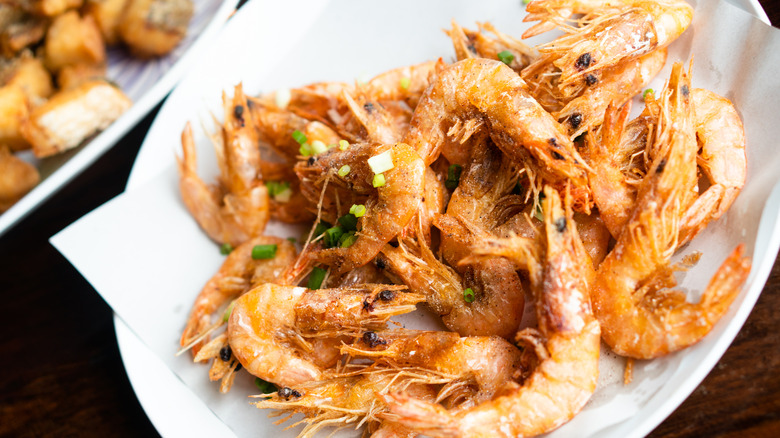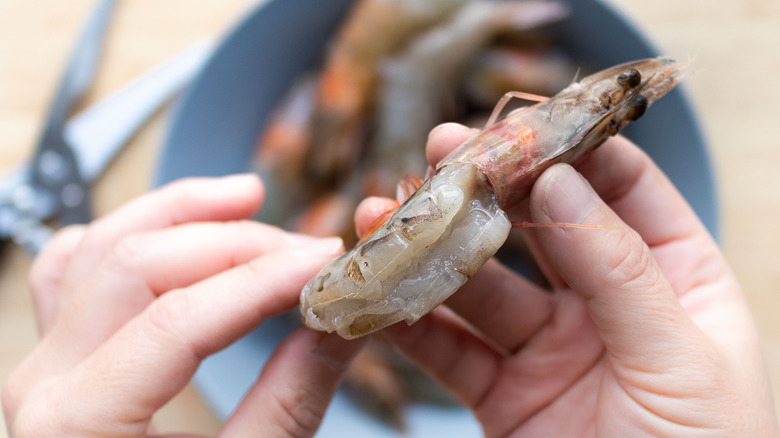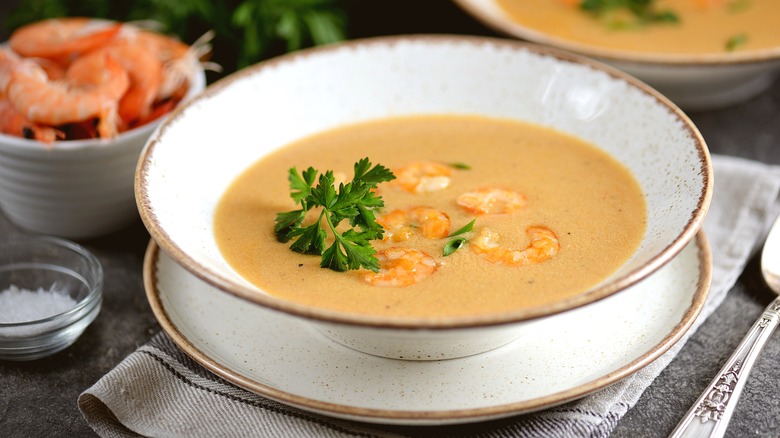All You Need To Do To Elevate The Flavor Of Shrimp Is Keep The Shells On
Shrimp is the most popular seafood in America. That's probably not surprising. You don't have to have seen "Forrest Gump" to appreciate the countless ways shrimp ends up on menus — and our dinner tables at home. Shrimp's mild, sweet flavor plays well in just about every cuisine. It's low in calories, nutrient-rich, and easy to prepare. The only downfalls seem to be a high amount of cholesterol and who likes to peel and devein shrimp?
Peeling all shrimp is one of the mistakes you need to avoid. There are plenty of instances when peeling isn't needed. While probably tough for most Americans to wrap their heads around, shrimp shells are edible. It's actually pretty common in much of the world, where shrimp are flash fried. For example, there's this Salt and Pepper Shrimp recipe from The Woks of Life. High, dry heat allows the shells to become thin, crisp, and tender. If done properly, the shells make for a delicious, light breading. So, that's not to be confused with the product of an absent-minded cook who forgot to peel the shrimp.
For moist cooking techniques, like a shrimp boil, or larger shrimp with harder shells, you'll still have to peel. But those shells are left while cooking for a reason. The theory is that the shell protects the delicate meat from overcooking. That might be true, but there's much more to it than that.
How shrimp shells elevate the flavor of shrimp
Shrimp shells do protect the meat. They're made out of a tough substance, called chitin, that can lock in flavor, but they provide as much flavor as they preserve. America's Test Kitchen explains that the chitin of shrimp shells is loaded with flavor compounds that transfer to the meat. Some of those compounds are the key components of umami, called glutamates. Umami is the tough-to-describe fifth taste that we find so irresistible. Meaty is probably the best one-word description, but umami is present in many not-meat foods, like tomatoes, mushrooms, green tea, soy sauce, and others.
In addition, the shell is full of protein and sugar, which are key to the Maillard reaction. It is the chemical process that food undergoes at high temperatures. That reaction is what explains caramelization, and why roasted, golden-brown food is more flavorful than poached, pale food.
Don't mistake not having to peel for not having to devein. That "vein" of digestive tract is fine to eat, but it can be gritty, or unappetizing to see. So, to devein shrimp with the shell, just run kitchen shears down the back of the shrimp. Often, the vein will come out on the shears. If not, simply pull it off.
If shrimp shells have to come off, be sure to save them
There are still recipes that require shelling. For example, this quick and easy shrimp ceviche. In these cases, be sure to save the flavor-packed shells. They are perfect fodder for shrimp stock. Unlike poultry or beef stocks, which can take hours to dissolve all of the gelatin from the bones or carcass, shrimp stock is ready in minutes and is key for flavorful chowder or any other seafood soup, bisque, or stew. Shrimp shells and diced vegetables give up their flavors quickly.
Many cooks keep a zipper-lock bag that they add shells to until they have enough to make a batch of stock. Martha Stewart's version is for a small batch that is a mere three ingredients and simmers for five minutes. Food Network's version uses more ingredients but is just as easy to make. Both of these can be stored in the fridge for several days, or a few months in the freezer.
Shrimp bisque is a surprisingly simple recipe that, in the case of this Cook's Country recipe, starts with a shrimp stock that's thickened with a roux. As soon as the shells and vegetables are strained out, the bisque just needs to be enriched with cream, and the shrimp added to poach. That final step takes five minutes. If you have a batch of shrimp stock in the freezer, this is an elegant meal that can be ready in about 20 minutes.


